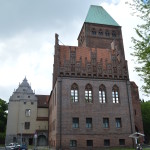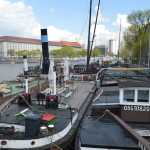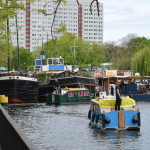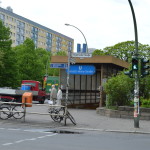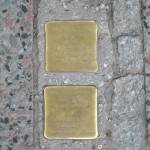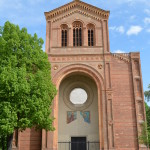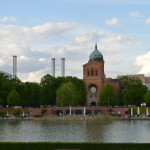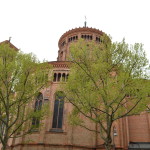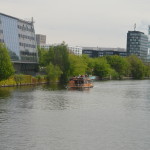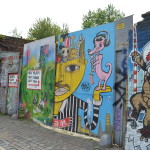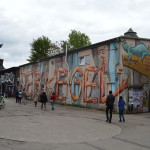Read more about the idea behind the walks here.
A map of the route (approx. 4.5 km): https://goo.gl/maps/h6x37.
Meeting place: Outside Märkisches Museum.
Completed in 1908, often mistaken for a church (which it never was) the building itself has an interesting history, and houses the museum of Berlin from the middle ages till now. http://www.en.stadtmuseum.de//node/1213, http://en.wikipedia.org/wiki/M%C3%A4rkisches_Museum.
To the right of the entrance are seven preserved segments of the Berlin wall, and a bit further to the right, at the entrance to the Lapidary in Köllnischer Park (http://en.wikipedia.org/wiki/K%C3%B6llnischer_Park), is a memorial statue of the artist/satirist Heinrich Zille (1858-1929). ‘His special talent was the scathingly humorous portrayal of what were in reality quite unfunny life conditions of handicapped beggars, tuberculous prostitutes, and menial labourers, and especially their children, making the best they could of life and resolutely refusing to give up’ (http://en.wikipedia.org/wiki/Heinrich_Zille).
Across the street we descend a few steps to walk along the Spree with a view to Jannowitzbrücke, named after cotton manufacturer Christian August Jannowitz who financed the bridge, built in 1882, destroyed during WW2 and rebuilt in 1954.
Behind/above it is the station of the same name(http://en.wikipedia.org/wiki/Berlin_Jannowitzbr%C3%BCcke_station) – originally from 1882, but the present form was completed in 1932. It was one of the ‘ghost stations’ for 28 years during the cold war. Straight ahead we have the Mühlendammschleuse http://de.wikipedia.org/wiki/M%C3%BChlendammschleuse_%28Berlin%29, which regulates a difference in water level of 1.5 m.
We then come to Berlin’s historical harbour: http://www.historischer-hafen-berlin.de/association.html, and Inselbrücke. The current bridge is from 1913, but there has been a bridge in this location since 1709.
Turning left on Inselstrasse, on the right-hand side, we pass U-Bahn Märkisches Museum http://en.wikipedia.org/wiki/M%C3%A4rkisches_Museum_%28Berlin_U-Bahn%29, opened in 1913, designed by Alfred Grenander, who designed the majority of the U-Bahn stations at the time. Bonus info: It is one of only two U-Bahn stations in Berlin with no central columns.
Outside Inselstrasse 12, we find five Stolpersteine (more about Stolpersteine here) – for David and Walter Abrahmsohn, and Ella, Günter and Leo Brauner. It is known that Ella and Günter Brauner were deported on the ’32. Osttransport’ within the ‘Fabrik-Aktion’, and Leo Brauner the day after, on the ’33. Osttransport’.
Further along, we come to Schulze-Delitzsch Platz, named after, and featuring a statue of, Franz Hermann Schulze-Delitzsch (1808-18883), ‘benefactor to the smaller tradesmen and artisans, created the world’s first credit unions, and along with Friedrich Wilhelm Raiffeisen created the cooperative movement in Germany’ (http://de.wikipedia.org/wiki/Schulze-Delitzsch-Platz; http://en.wikipedia.org/wiki/Franz_Hermann_Schulze-Delitzsch).
Staying on the right-hand side of the street, now Köpenicker Strasse, we pass three Stolpersteine for Elisabeth, Gertrud and Max Schie, two sisters and a brother, who led a not particularly lucrative existence as dress makers, and were deported to Riga in 1942: http://www.stolpersteine-berlin.de/en/biografie/602. A bit further on, right outside Heinrich-Heine-Strasse U-Bahn station, another one, for Martin Cohn, who was a dentist. After Jews were forbidden to practice their trade in the 1930s (which caused many Jews, especially university-educated, to commit suicide), Martin Cohn continued to treat patients in the Jewish community. He and his wife were deported to and murdered in Auschwitz. They had two daughters. One was sent to the UK at the age of 15 in 1939 and later moved to USA. The other survived Theresienstadt but later died as a consequence of the conditions in the ghetto.
Next we pass Heinrich-Heine-Strasse U-Bahn station, opened in 1928, also designed by Alfred Grenander, and as such a protected architectural landmark. After the construction of the Berlin Wall, the station was closed and blocked to the point that it was invisible from the ground, hence the less than attractive new entrance, and became one of the ‘Geisterbahnhöfe’. http://en.wikipedia.org/wiki/Heinrich-Heine-Stra%C3%9Fe_(Berlin_U-Bahn).
Crossing and turning right into Heinrich-Heine-Strasse, picking up speed to get a boring stretch over and done with, we come across another two Stolpersteine, for Georg and Käthe Licht. In 1941, their daughter Alice had started working in Otto Weidt’s broom and brush workshop (now a museum: http://www.museum-blindenwerkstatt.de/en/ausstellung/themen/otto-weidts-workshop-for-the-blind/), originally recruiting blind and deaf people, and later increasingly recruiting Jews for forced labour. With the help of Otto Weidt, they were able to hide for a while but were arrested and deported on the ‘98th transport’ in 1943 to Theresienstadt, from where the parents were transported to Auschwitz where they were murdered. In January 1945, also with the help of Otto Weidt, Alice managed to escape from Gross-Rosen concentration camp and emigrated shortly after the war to the United States. She died in 1987 in Israel.
Turning left on Dresdener Strasse, where we meet the row of double cobble stones which in many places, but not all, shows the trajectory of the wall.
From here and for the rest of the walk, we will be following the trajectory of the wall, although it is not always marked.
Turning left on Waldemarstrasse, we come to Luisenstadt Canal: http://en.wikipedia.org/wiki/Luisenstadt_Canal (briefly: built between 1848 and 1852 for water transport and land drainage, as well as to function as a decorative strip, flanked by quays lined with neoclassical buildings. Partially filled in between 1926 and 1932 and transformed into a sunken garden. Badly damaged during WW2 and subsequently filled with rubble. Since 1991 some parts of the sunken garden has been restored to the design of 1928.) Also more here: http://www.berlin-hidden-places.de/yuba_web3/regional_en/mitte/mit_luisekanal_en.htm.
Arriving at Engelbecken, http://www.kreuzberger-chronik.de/chroniken/2004/dezember/geschichte.html, there is time for a coffee break at Café am Engelbecken and/or a closer look at Michaelskirche (which is unfortunately closed except for mass and Sundays from 15.30 to 17.00), a Roman Catholic church completed 1851: http://en.wikipedia.org/wiki/St._Michael%27s_Church,_Berlin, http://www.berlin-hidden-places.de/yuba_web/regional_en/mitte/mitte_michaelskir_en.htm.
After about half an hour, we meet back on the corner of Leuchnerdamm and Bethaniendamm. Walking along Bethaniendamm we come to the northern corner of Mariannenplatz with St-Thomas-Kirche: http://www.stthomas-berlin.de/, which we have a few minutes to visit if it is open.
Further along Bethaniendamm, we come to “Baumhaus an der Mauer”, which was situated in “No-man’s-land” during the cold war, built by Anatolian immigrant Osman Kalin, who can still be seen sitting in the garden watching the world go by, occasionally waving to passers-by, now a bit of a tourist site, administered by one of Mr Kalin’s sons (http://de.wikipedia.org/wiki/Baumhaus_an_der_Mauer, and in English here – it’s a good story: http://www.secretcitytravel.com/berlin-april-2014/treehouse-on-the-berlin-wall.shtml).
And the last photo was obtained with Mr Kalin’s permission.
Moving on, crossing Schillingbrücke, http://www.stadtentwicklung.berlin.de/bauen/ueberbruecken/en/text_23.shtml, http://de.wikipedia.org/wiki/Schillingbr%C3%BCcke, from the 1870s, to the right we have a view of our end goal, Oberbaumbrücke, in the distance.
Turning right on Stralauer Platz, we soon come to our home stretch – East Side Gallery: http://en.wikipedia.org/wiki/East_Side_Gallery and http://www.berlin.de/orte/sehenswuerdigkeiten/east-side-gallery/index.en.php (just in case it still needs an introduction, especially after all the palaver about the bits that had to be removed in order to build the new building right next to it).
Our walk ends at Oberbaumbrücke http://en.wikipedia.org/wiki/Oberbaum_Bridge, from 1896. During the cold war, from 1963, the bridge was exlusively used as a pedestrian border crossing for West Berlin residents only. Reopened to pedestrians and traffic in 1994, and to U-Bahn in 1995.
In 1997, a neon installation entitled “Stone-Paper-Scissors” by Thorsten Goldberg was installed on the bridge (http://www.secretcitytravel.com/berlin-august-2014/oberbaumbruecke-berlin-art-light-installation.shtml). Its two elements are engaged in a constant game of rock, paper, scissors, suggesting the arbitrariness of immigration decisions, both during the Cold War and for today’s asylum seekers and poverty migrants.
Looking further east along the river, we catch a glimpse of the sculpture ‘Molecule Man’ by US artist Jonathan Borofsky: http://en.wikipedia.org/wiki/Molecule_Man_%28sculpture%29.
After the walk in May 2015, some of us continued to this beer festival: http://www.braufest-berlin.de/en/.




